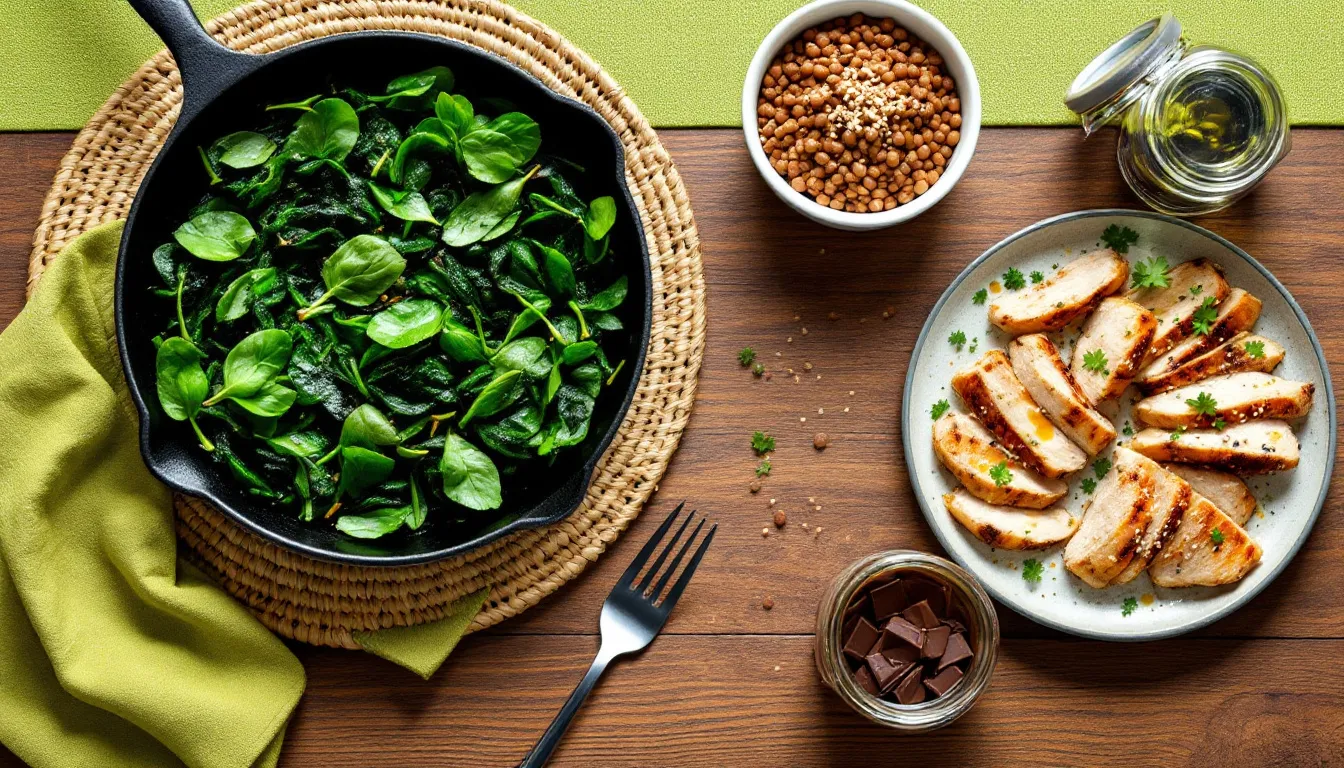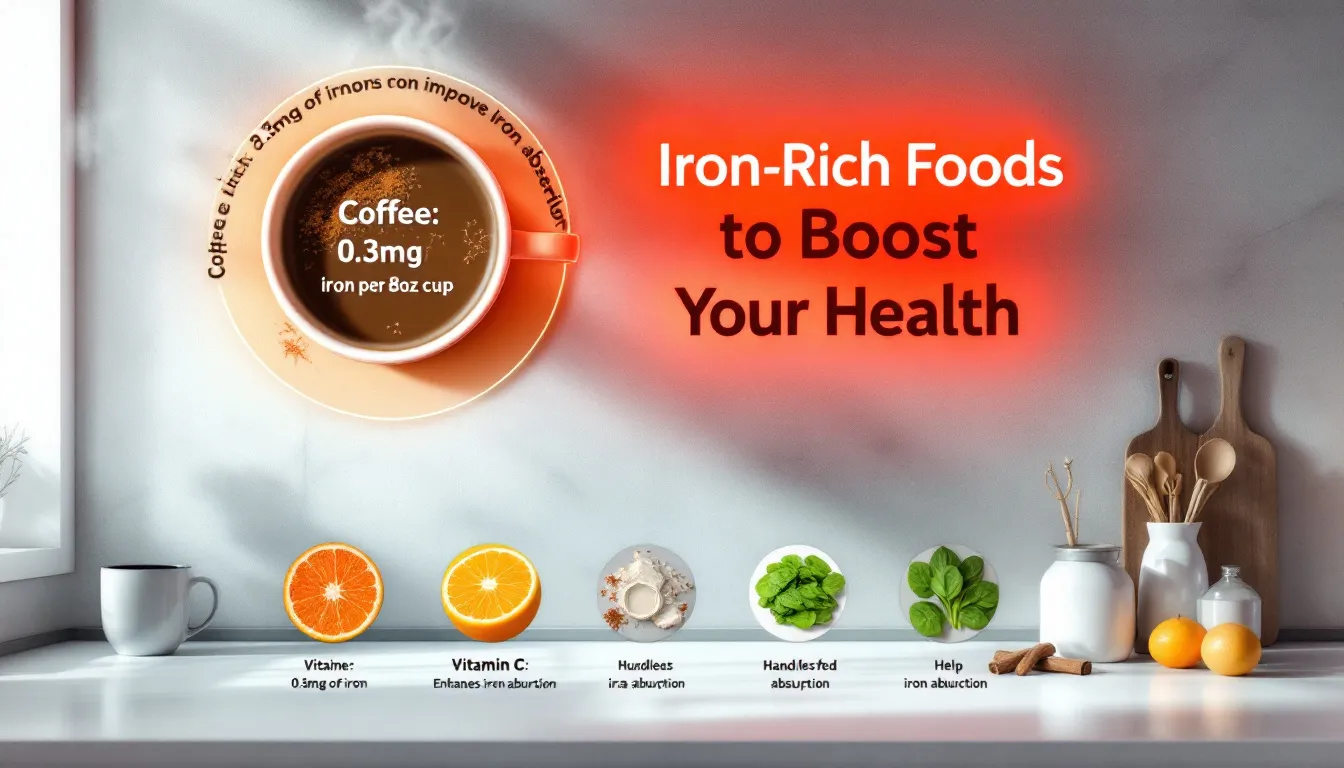Looking to boost your hemoglobin levels quickly and naturally? This guide will show you specific foods that can help increase hemoglobin levels. Whether you’re dealing with iron-deficiency anemia or just want to maintain healthy levels, the right diet, including foods increase hemoglobin level, can make a significant difference.
Key Takeaways
- Maintaining adequate iron levels is crucial for producing hemoglobin, which is essential for oxygen transport in the body.
- Incorporate both heme (animal sources) and non-heme (plant sources) iron into your diet, and pair non-heme sources with vitamin C to boost absorption.
- Be mindful of foods that can hinder iron absorption, like those high in calcium and certain compounds in tea and coffee.
Hemoglobin and Its Importance
Hemoglobin is the vital protein in your red blood cells responsible for transporting oxygen from your lungs to all the tissues and organs in your body. Imagine every cell in your body as a tiny engine that needs oxygen to run efficiently. Hemoglobin is the delivery truck that ensures each engine gets its fuel. Once it drops off oxygen, it picks up carbon dioxide—a waste product—and transports it back to your lungs for you to exhale.
The iron in hemoglobin is what enables it to bind with oxygen. Without enough iron, your body struggles to produce hemoglobin, leading to a condition known as iron deficiency anemia. This condition can result in fatigue, weakness, and a host of other health issues. That’s why maintaining adequate iron levels is crucial for hemoglobin production and overall health.
Proper hydration also plays a role in hemoglobin function. Staying hydrated ensures optimal blood circulation, which supports the effective transport of oxygen and other nutrients throughout your body. So, drinking enough water is a simple yet powerful way to support your hemoglobin levels.

Iron-Rich Foods to Boost Hemoglobin Levels
Adding iron-rich foods to your diet boosts hemoglobin levels. These foods provide the nutrients needed for healthy red blood cell production. Whether you have low hemoglobin or just want to maintain adequate iron, a diverse intake of iron-rich foods is key.
There are two types of dietary iron: heme and non-heme. Heme iron, found in animal products, is absorbed more efficiently by the body. Non-heme iron, found in plant-based foods, is also important but requires a bit more effort to absorb. Both types are crucial for maintaining your iron levels and supporting overall hemoglobin production.
Heme Iron Sources
Heme iron sources are your best friends when it comes to boosting hemoglobin quickly. Foods like beef, lamb, turkey, and chicken are among the top sources of heme iron. These options are not only delicious but also highly effective in enhancing iron absorption.
Seafood lovers can rejoice as well. Shrimp, clams, and tuna are excellent sources of heme iron. And don’t forget organ meats like liver, which are among the richest sources of heme iron, supporting effective hemoglobin synthesis. Including these foods in your diet can make a significant difference in your hemoglobin levels.
Non-Heme Iron Sources
For those who prefer plant-based options, dark green leafy vegetables like spinach and kale are fantastic sources of non-heme iron. Lentils, beans, and fortified cereals also pack a punch when it comes to non-heme iron content.
While it’s true that non-heme iron is less readily absorbed by the body compared to heme iron, you can still boost its absorption by pairing these foods with vitamin C-rich options. This strategy will help ensure you’re getting the most out of your iron intake.
Enhancing Iron Absorption
Enhancing iron absorption maximizes the benefits of iron-rich foods. Pairing these foods with specific nutrients greatly aids hemoglobin production.
We explore the role of vitamin C and other nutrients in this process.
Vitamin C-Rich Foods
Foods rich in vitamin C are a game-changer for anyone looking to boost their iron absorption. Citrus fruits like oranges, strawberries, and bell peppers are excellent choices. Consuming these iron rich food alongside iron-rich meals can significantly enhance the absorption of non-heme iron.
This combination works wonders because vitamin C transforms iron into a form that is easier for your body to absorb. So, next time you’re enjoying a spinach salad, consider adding some strawberries or squeezing a bit of lemon juice on top to enhance the iron absorption.
Other Nutrients That Aid Iron Absorption
Beyond vitamin C, other nutrients like vitamin A and beta-carotene also play a significant role in enhancing iron absorption. Vitamin A aids in releasing stored iron in the body, which helps prevent iron deficiency anemia. Foods rich in vitamin A, such as carrots and sweet potatoes, can improve your body’s ability to absorb iron from plant sources.
Here’s a quick list of iron absorption boosters:
- Vitamin A: Found in carrots, sweet potatoes, and spinach, it helps improve iron utilization.
- Beta-carotene: This nutrient, found in colorful vegetables, converts into vitamin A in the body and further enhances iron absorption.
Incorporating these nutrients into your diet can make a significant difference in maintaining adequate iron levels and improving overall health.

Foods to Avoid for Better Iron Absorption
Focusing on iron-rich foods is important, but it’s also necessary to recognize foods that hinder iron absorption. Certain substances, like calcium, can reduce iron uptake when consumed with iron-rich foods.
Here are some foods and substances to watch out for:
- Phytic Acid: Found in whole grains and legumes, it can significantly reduce iron absorption.
- Tannins: Present in tea and coffee, these compounds can hinder iron absorption from meals.
By moderating the intake of these foods or consuming them separately from your iron-rich meals, you can increase iron absorption and improve your body absorbs ability to absorb iron from more iron rich foods more effectively.
Additional Dietary Tips for Increasing Hemoglobin
In addition to iron-rich foods and absorption techniques, other dietary strategies can boost hemoglobin levels. Proper hydration supports overall health and helps maintain adequate blood volume.
Additionally, consuming foods rich in folate, such as green leafy vegetables and legumes, can support the production of hemoglobin.
Iron-Fortified Cereals and Grains
Iron-fortified cereals and grains are a convenient way to increase your iron intake. Many breakfast cereals, like Multigrain Cheerios and Grape Nuts Flakes, are enriched with iron. These cereals can significantly enhance iron intake, which is crucial for raising hemoglobin levels.
These cereals offer a reliable source of iron, helping meet daily iron needs, particularly for those with higher requirements.
Hydration and Physical Activity
Proper hydration and regular physical activity are essential for a healthy lifestyle and can enhance hemoglobin production. Adequate hydration supports various bodily functions, including hemoglobin function.
Regular exercise stimulates healthy red blood cells production, which is vital for increasing hemoglobin levels. Combining hydration with physical activity creates a favorable environment for hemoglobin production and overall health improvement.
When to Consider Iron Supplements
Dietary changes might not always suffice for maintaining iron levels. In such cases, iron supplements can offer quicker results and are often recommended for iron deficiency anemia and those who are iron deficient.
Consult a healthcare provider before beginning any iron supplement regimen. Unsupervised use can lead to health complications, including organ damage.
Monitoring and Maintaining Healthy Hemoglobin Levels
Regular hemoglobin count tests assess overall health and diagnose conditions like anemia. Monitoring levels tracks treatment effectiveness and allows for timely adjustments.
For those at risk of iron deficiency, regular testing of iron levels is advised to ensure timely treatment and prevent complications. Abnormal hemoglobin levels, including a low hemoglobin count, can indicate various health issues, necessitating further medical evaluation.
Frequently Asked Questions
What are the best sources of heme iron?
The best sources of heme iron include beef, lamb, turkey, chicken, shrimp, clams, tuna, and organ meats like liver. Including these in your diet can really boost your iron levels!
Which foods are rich in non-heme iron?
You’ll find non-heme iron in dark green leafy vegetables like spinach and kale, as well as in lentils, beans, and fortified cereals. Including these in your diet can help boost your iron intake!
How can I enhance iron absorption from my diet?
You can enhance iron absorption by pairing iron-rich foods with vitamin C sources like citrus fruits and bell peppers. It’s a simple tweak that can make a big difference!
What foods should I avoid to enhance iron absorption?
To boost your iron absorption, steer clear of foods high in calcium, phytic acid (like whole grains and legumes), and tannins found in tea and coffee, especially when you’re eating iron-rich meals. It’s all about timing those meals right!
When should I consider taking iron supplements?
You should consider taking iron supplements if you’re unable to get enough iron from your diet or if you’ve been diagnosed with iron deficiency anemia. Just remember to talk to your healthcare provider before starting any supplements!


